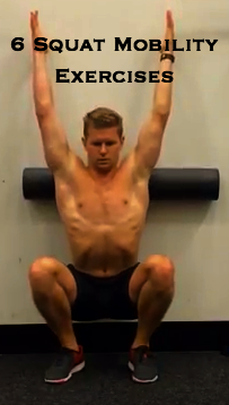|
Can you keep your torso tall as you lower into the squat? Do your heels pop off the ground? Do your knees cave towards one another?
What Do You Need to Know About Squatting The squat is considered a compound, multi-joint movement that targets the gluteals, hamstrings, and quadriceps. When performed correctly, it activates over 200 muscles. The single leg squat shows exceptional muscle activation of both the gluteus medius and gluteus maximus (1). These muscle groups are extremely important in decreasing your risk of low back, hip, and knee pain. Essential Mobility Exercises As I mentioned above, a proper squat requires coordinated movement in the ankles, hips, core, and middle back. Typically a loss of mobility in one of these regions is a contributing factor to someone's inability to squat. Below are the TOP 6 exercises I routinely perform to maintain good squat form.
Like this post? See more resources from Heafner Health
5 Comments
Manuel Franco
8/29/2023 10:22:34 pm
I just want to say Thank You to everyone who supported me through the years. My name is Manuel Franco, New Berlin, Wisconsin. My story of how I won the Powerball lottery of $768.4M is a bit of a tale. I have been playing Powerball tickets for 6 years now since I turned 18. I bought my first ticket on my 18 birthday. I was feeling very lucky that day because I had contacted Dr. Odunga Michael to help me with the winning Powerball numbers. I really had that great great feeling that I looked at the camera wanting to wink at it. I only did a tiny part of it and trusted him. He gave me the numbers after I played a couple other tickets along with it for $10. I checked my ticket after the winnings came online and saw the numbers were correct including the Power play. I screamed for about 10 minutes because it felt like a dream. I had won $768.4M. You can check my winning testimony with the lottery officials just with my name search. Thank you Dr Odunga. Well, his email is [email protected] and you can also call or Whats-app him at +2348167159012 so you guys can contact him
Reply
Hailey Garcia
6/20/2024 10:45:30 pm
My name is Hailey Garcia and I am from New Jersey. My herpes virus turned to war after 2 years of living with it. I have tried different medical procedures to cure my herpes but to no avail. Most people think herpes is only a minor skin irritation of which herpes has long term effects on health and passes through the bloodstream and can be easily contracted through sexual intercourse. I knew I had herpes from the first day I started feeling itchy in my pubic area and the pain was very unbearable. I couldn't stand it anymore. After 2 years of trying other means to get rid of it, I had to contact Doctor Odunga to help me with a permanent cure. I saw his email and whats-app number from a testimony I read online from a lady who was also helped by him in curing infertility problems, I had faith and contacted him. He assured me of his work and I ordered his herbal medicine. Within 5 days, I didn't feel any pain anymore and within 2 weeks, my skin was all cleared and smooth. I am very grateful to you sir and I write this testimony as others have done to bring those having faith to you sir. If you have herpes or other similar disease and you want it cured, kindly contact Doctor Odunga, Whats-App (wa.me/+2348167159012) OR Email [email protected]
Reply
obodubu monday
7/18/2024 02:13:53 am
Dr. Obodubu Monday is recognised all over the world of marine kingdom, As one of the top fortunate and most powerful spell casters doctor of charms casts from the beginning of his ancestors ship until now Dr. Obodubu Monday lives strong among all other spell casters, there have never been any form of impossibility beyond the control of Dr. Obodubu Monday it doesn’t matter the distance of the person with the problems or situation, all you have to do is believe in the spell casting Dr. Obodubu Monday cast that works, he always warns never to get his charms cast if you do not believe or unable to follow his instruction. it is the assignment of the native doctor Dr. Obodubu Monday to offer services to those in need of spiritual assistance not minding the gravity of your situations or distance as long as water, sea, ocean, lake, river, sand, etc. are near you, then your problems of life would be controlled under your foot. if you need any spiritual help on any of these WhatsApp Doctor Obodubu on : +234 705 993 7909
Reply
QUEEN
7/18/2024 02:20:57 am
Hi guys, i don’t have much to say now now, Than to say thanks to Dr. Monday for rescuing me and my family from poverty, and for getting my husband and my Job back, i love playing lottery , but winning is my biggest problem, Ill never forget the day i come in contact with Dr Monday, whose lottery spell make me a winner, some million Dollars , after giving me a sure winning numbers within 3 days to play,my financial status is settled for good,now i have started to live my dream life after 12 years of playing the lottery A big thanks to Dr Monday, am grateful for all you have done for me and family, he can be reach on Via WhatsApp +234 705 993 7909
Reply
Leave a Reply. |
Heafner HealthPhysical Therapy Archives
April 2024
Categories |


 RSS Feed
RSS Feed
